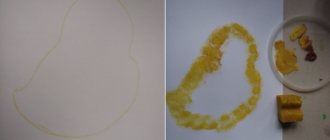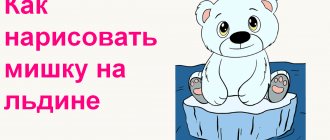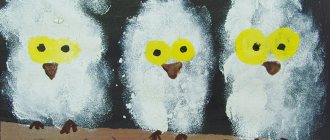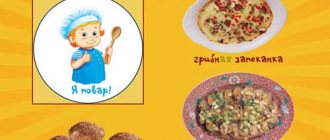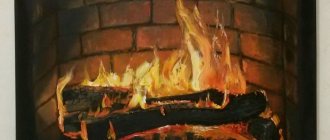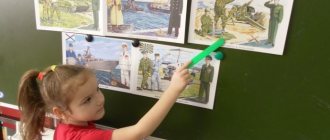NOD "Russian folk sundress"
Summary of an open lesson on artistic creativity using children's design technology:
“Russian folk sundress” (senior group).
Target:
introduce children to Russian folk costume.
Tasks:
— To develop in children the desire to draw a pattern, arranging it rhythmically, to combine colors beautifully, to place the pattern on a given shape, to develop visual attention, to teach how to draw a pattern.
— Continue to develop respect for the traditions of the Russian people, introduce children to the history of Russian clothing, the peculiarities of the appearance of Russian folk costume.
— Continue to introduce ornaments in Russian folk costume.
— Practice the technique of working with a brush: the tip of the bristles, cotton swabs.
— Form aesthetic taste, develop creative imagination.
- Foster love and respect for your homeland.
Preliminary work:
1. Examination of illustrations “Russian folk costume”;
2.N NOD “Russian folk costume”;
3. Conversations on the topic “Clothes of our ancestors.”
4. Didactic game “Dress the doll in Russian folk costume.”
Material and equipment:
contours of the image of a sundress, presentation “Russian folk costume”, brushes, cotton swabs, gouache, rags, samples of embroidery patterns of sundresses, a doll in a Russian folk costume.
NNOD move:
Educator:
Educator: - Guys, let's smile at our friends, all the guests, give everyone the warmth of our smiles and hearts, so that everyone can feel joyful, bright, and comfortable here.
Educator
: Guys, I came to the nursery today and they gave me this. (there is also an address written on it) What is this?
Children's answers: (chest).
Educator: That's right guys, this is a chest in which clothes used to be stored. Let's see what's there. Open the chest, see the letter here.
Educator
: People used to dress differently than we do now.
Dear Guys ! Russian beauties write to you. We wanted to go to the fair, where, according to tradition, girls wear the most elegant, beautiful clothes. And when we took out our sundresses we saw that all the patterns on them had disappeared. Guys, we ask you to help us get to the fair. We will be very grateful to you. Guys, we will help Russian beauties get to the fair.
Children's answers.
(yes we will help)
Educator
: How can we help, return the patterns?
Children's answers
(Draw, cut and paste, embroider, sculpt from plasticine.)
Educator:
Guys, do you think girls used to dress the same way as they do now or differently?
Children's answers:
in another way, their clothes were different and they decorated their clothes with other patterns.
Educator
:I want to show you how Russian beauties used to dress. (presentation) The clothes were loose, long and unusually beautiful. It was sewn from linen fabric.
Summary of GCD in kindergarten in the senior group. Russian folk costume
Abstract of GCD in senior groups on the topic “Russian folk costume”
Goals and objectives: to form students’ ideas about Russian folk costume, to supplement knowledge about its elements and details, to broaden their horizons, to develop curiosity; form figurative speech; enrich your vocabulary; instill love for your homeland; to form aesthetic taste; cultivate interest in folk life. promote the manifestation of pride in belonging to Russian traditional culture. Form: conversation Enrichment and activation of the vocabulary: shirt-kosovorotka, caftan, kokoshnik, cap, dushegreya, ports, zipun, onuchi, bast shoes, apron, poneva, gashnik, corolla, kichka, magpie, cap, cap. Preliminary work: Reading fiction, reading children's encyclopedias - sections on Russian folk clothing; looking at clothes in reproductions of famous artists; learning short stories about ancient Russian clothing with children, designing the “Kokoshnik” exhibition. Equipment: illustrations for the fairy tales “The Ryaba Hen”, “The Frog Princess”, “Khavroshechka”, “Sister Alyonushka and Brother Ivanushka”, illustrations of Russian folk costumes
Progress of the conversation
1. Introduction. Formulating the topic of the lesson And a beautiful girl greets us! For us Russians, it is very useful to know Russian costume History! A suit will encourage you to think about people, and can tell you about everyday life and morals. We will not cultivate an ignoramus within ourselves, Let's walk through the exhibition slowly, Let's look at Russian clothes: Isn't it simple and good! — Where can you and I see Russian folk costume? Children: In museums, at exhibitions, in paintings, in fairy tales, in films, at folk festivals. Educator: Now sit down more comfortably. We will talk about ancient Russian costume. I will try to tell you something interesting about him, something that you don’t know yet. Guys, today we will talk about the history of Russian folk costume. What does "clothes in general" mean? What did the ancient Slavs call “clothing in general”? In Ancient Rus', clothing was called “clothing”. The word robe, which has a certain solemn meaning for us, was also often used by the ancient Slavs to mean “clothing in general.” Indeed, let's listen: clothing is what clothes. — The history of Russian folk costume goes back many centuries. - How can we find out what clothes were like before? Sources for studying the history of clothing are museum collections, frescoes, icons, and chronicle sources. 2. Main part What element of clothing is the basis of the Russian costume? The shirt (shirt, undershirt, toe cap) is the oldest, main element of Russian folk costume. - Guys, today we will visit a fairy tale. Look carefully at these illustrations. What fairy tale is this illustration from? (“The Ryaba Hen”, “The Frog Princess”, “Khavroshechka”) Notice how the grandmother is dressed? (sundress, shirt, scarf, bast shoes) - How is grandfather dressed? (kosovorotka, ports, bast shoes) In the illustration for which fairy tale, are the clothes elegant, festive? (“The Frog Princess”, “Khavroshechka”) Which illustration shows work clothes, and which shows everyday clothes? (“The Ryaba Hen”, “Sister Alyonushka and Brother Ivanushka”) Why do you think that the clothes here are smart? (decorated, embroidered, kokoshnik, boots) - Why do you think that the clothes here are casual? (simple sundress, scarf) Now let's look at Russian folk costumes. The main clothing for both men and women was a shirt. Men's shirts were always sewn in a loose fit. The shirt reached to the knees and had a slit at the collar - either in the middle of the chest or on the side (kosovorotka). The shirt had no collar. They wore a shirt with a belt. Women's shirts differed from men's in length, which reached the ankle; they were made from linen fabrics and decorated with embroidery. They wore a shirt with a narrow belt. - What did they wear with the shirt? Over the shirt, married women usually wore a ponyova - a skirt not sewn, but wrapped around the figure and secured around the waist with a cord - a gashnik. Poneva is the oldest item in a woman’s wardrobe. An apron was tied over the ponyova, an important part of a woman’s costume. - Why do you think it is called that? Children: Worn from the front. — Let's consider a woman's suit. The main part of a woman's costume is a chemise (shirt), a sundress. But here is a beautiful and comfortable outfit - a sundress. It was worn by both young girls and married women. Swing sundress, wide, long, sleeveless clothing with straps. Sundresses were made from different fabrics and decorated with embroidery and braid. A soul warmer was put on top of the sundress - a short garment, just below the waist, with sleeves or sleeveless with straps. The front of the soul warmer was fastened with a button. The summer one is longer, for the winter they sewed an insulated and shorter one. A kokoshnik was worn on holidays, a kichka was worn by women, a ribbon - a braid - by girls. The clothing of Russian peasant women was characterized by the design of a shirt, consisting of two panels of canvas covering the back and chest, and connected at the shoulders by quadrangular pieces of fabric - polyki. These policies. What were the costumes decorated with? (beads, bugles, embroidery) The shirt was traditionally decorated with hand embroidery or patterned fabric. Stripes of ornament, and at a later time, ribbons, braids, colored lace, were necessarily located along the hem, the edges of the sleeves, on the shoulder, along the collar and along the slit on the chest. But the wedding shirt was rightfully considered the most beautiful. It was embroidered with multi-colored patterns, where the main place was occupied by red. The young wife wore it for several more years on major holidays, and then carefully stored it. Women were engaged in spinning and weaving cloth. They believed that only kind female hands that did not hold weapons could be trusted to make clothes. Almost all women in rural, and at first in urban families, owned this craft. Let's play the round dance game "Needle, thread, knot." Now let's look at a men's suit. What did the men wear? Let's get a look. An obligatory part of the clothing of Russian men were ports - narrow, long trousers, tapering towards the bottom and reaching the ankles. The shirt was made long and belted with a sash. -What was the belt for? The belt was a mandatory part of the costume. It protected its owner; a knife, a spoon, a comb and a special bag that replaced pockets were hung from it. And when it got colder, they took warm clothes out of their chests and prepared for winter. — What kind of clothes were worn in Rus' in winter? (dushegreya, quilted jacket, caftan, fur coat, sheepskin coat) The caftan was worn over a zipun, it was knee-length and longer, it was fastened with hooks and belted with a sash. Telogrea was insulated with cloth or fur. Everyone wore fur coats, men, women and children. The main part of a men's suit is a blouse and ports. What are these clothes called? (kosovorotka, ports) On the head? (cap) Shoes - boots, bast shoes. Two boots - a pair and both on the left foot. In those days, boots were made identical for both feet and acquired the desired shape only when they were worn in. — What other shoes are you familiar with? Children: bast shoes, felt boots. “It takes five pairs of whips to go on the road,” people said; the bast shoes were worn for a very short time. Why? — The peasant, the city dweller and the boyar wore a shirt of the same cut, the difference was only in the quality of the fabric. And the order of decorating clothes was strictly observed: patterns were located on the collar, shoulder, on the low sleeves and hem of the shirt. Festive and ritual shirts were especially richly decorated. So, on the first day of harvesting herbs, it was supposed to go out in a “mow” with a wide patterned stripe along the hem. On the holiday of the harvest, they dressed themselves in a “reaping” shirt. — In folk costume, as a rule, more attention was paid to women’s clothing, since it was primarily designed to protect the health of the continuator of the family. However, men's clothing, despite the smaller amount of decoration, was also treated with due respect and attention. Children's clothing in Ancient Rus', for both boys and girls, consisted of one shirt. Boys and girls received the right to adult clothes not just after reaching a certain age, but only when they could prove their “adulthood” with deeds, that is, they had to pass a certain test - In ancient Rus', they mostly sewed clothes themselves. What can clothes be made from? (from fabric, leather, fur) What do you call a person who sews clothes? (tailor - from the word ports) At all times, people took care of their clothes so that they looked beautiful and neat. There were no washing machines then. Where and how do you think the clothes were washed? Children: Trough, tub. Educator: First, the linen was soaked so that it could be washed better. Where do you think the linen is washed? Children: River. They folded the laundry on a large stone and hit the linen with a special stick, and then rinsed it in the river, wrung it out by hand and put it in baskets. In Rus' there were unique devices for washing, ironing and storing linen. Our ancestors have long come up with different ways to prevent things from remaining wrinkled after washing. The rubel was called a rolling stick; it was used to smooth out wrinkles in linen after washing it. One side is flat and the other is ribbed. For ironing, they also used a roller, on which the linen was wound, and rolled with a ruble. Valek and Rubel are two inseparable friends. In a linen country A steamboat floats along the Sheet River: Now back, now forward. And behind him there is such a smooth surface - Not a wrinkle can be seen. (Iron) Irons appeared later. Even in those days, irons were different. The oldest can probably be considered solid cast iron. It was very heavy because it was solid cast iron or bronze and was heated over an open fire. And they put them in chests. - Let's show how they washed and ironed clothes. Imitation of “Washing” movements (soaked, washed, rinsed, wrung out, shook, hung, removed, ironed, folded) What materials were the fabric made from? Cotton, linen, silk, nettle, wool. A variety of fabrics were made from these materials: linen - linen, cotton - cotton, wool - wool, silk - silk. Do you think it was easy to make clothes from them? — In order to get, for example, a shirt from a flax seed, it was necessary to perform many actions. Let's list what people did. (They sowed flax, weeded it, harvested it from the field - reaped it with a sickle, soaked it, ruffled it to get fibers - tow; they spun threads from the tow, wove canvas from the threads, then bleached it - spread it out in the cold, dried it in the sun; cut clothes, sewed it, they embroidered patterns on it. Sometimes the canvas was painted.) - Was such work done quickly? (They sowed in the spring, weeded in the summer, harvested in the fall, and in the long evenings in winter they spun threads and wove linen.) This is where the tradition came from - gathering for gatherings at which people played, joked, sang songs, but at the same time did not forget about important and necessary matters . “It was hard and long work, but what a beautiful result!” Notice how beautiful the decorations are on all the clothes. In jewelry and embroidery, preference was often given to red. Even the proverb says: “The color red is dear to the whole world.” Do you know why? What does the color red remind you of? (Fire, sun.) Fire and sun were very important for people, so red was the color of protection from the forces of evil, from various misfortunes. In the old days, the word “red” also meant “beautiful,” they said “red maiden,” “red sun.” — How did people feel about clothes? (Very carefully in order to wear it longer, and elegant sundresses, kokoshniks, shirts were worn on holidays and passed on to their children and grandchildren). A beautiful belt and an embroidered shirt were the best gift. Each nation had its own special costume. Look at these costumes (Evenk and Arab costumes). — A suit is the pride of the people. Every person loves his folk costume very much, is proud of it, and glorifies it in songs. Nowadays it is worn on special occasions (meeting with foreign guests, holidays). Fashion designers use elements of folk costume to decorate modern elegant toilets; masters store and pass on to others the skills of creating a costume and its elements - embroidery, weaving belts, making hats).
3. Conclusion. Summing up Guess the riddles of grandma's old chest! - A leaky trough (bast shoes) is made from bast - Don’t sulk, but stick your head over your head (shirt) - I walked along the road, I found two roads, I went along both (ports) - If I put it on, it will be cramped with a rim, If I take it off, it will fall like a snake. (belt) - What did you learn today in our conversation? — What new words did you hear? — Today we learned a lot of interesting things about Russian costume, traditions and customs in Rus'. Well done! We will still learn a lot of new things about the Russian people, about the life of our people.
We recommend watching:
GCD summary in the senior group on familiarization with the outside world on the topic: Winter GCD summary on the formation of a healthy lifestyle in the senior group GCD summary on cognitive and speech development with elements of museum pedagogy in the senior group GCD synopsis on physical education in the senior group
Similar articles:
Abstract of GCD in the senior group on cognition on the topic “Furniture Factory”
Abstract of educational activities for cognition in the senior group of kindergarten on the topic “Russian folk toys”
Summary of a lesson on cognition in the senior group of kindergarten on the topic: Hearing organs
Conversation in the senior group of kindergarten on the topic: What are fabrics for?
Summary of a lesson on cognition in the senior group on the topic: My city Voronezh
OOD abstract on drawing “Russian sundress”
Summary of direct educational activities in the senior group
Topic: “Russian sundress”
Prepared by:
Teacher Asafova
Irina Vladimirovna
Let's play, 2015
Target:
To develop an interest in Russian applied art, a desire to know and use oral folk art in life.
Integration of educational
areas:
“Cognition”, “Artistic Creativity”, “Socialization”, “Communication”.
Tasks:
-introduce children to traditional Russian costume, folk customs and clothing decorations;
- to arouse interest in the life of our ancestors;
- to cultivate in children love and respect for the folk culture and traditions of the Russian people, the creativity of the Russian people, and the desire to create themselves.
Preliminary work:
acquaintance with oral folk art: reading Russian folk tales “Sivka-Burka”, “The Frog Princess”, “Khavroshechka”, sayings, proverbs. Acquaintance with the elements of Russian folk costume, Russian folk games “Zhmurki”, “Traps”.
GCD move:
Educator: The Russian people are talented in everything: both in work and in leisure. Russian folklore still surprises us with proverbs, sayings, and nursery rhymes. Let's remember which ones you know?
Children's answers: “Patience and work will grind everything down,” “You can’t even pull a fish out of the pond without work.”
Educator: Well done guys! And the people also said: “Like the spinner, so is the shirt.” Today, we will look at what the Russian costume was like. And then we'll draw it.
(Show the children a Russian folk costume or a doll in this outfit)
.
But how much work people put into creating such beauty. This costume was worn by Russian women. The suit is many years old, but it looks like new. Do you know why?
Children's answers.
Educator: It was sewn with love, stored very carefully and worn only on holidays. Therefore, the costume pleases our eyes even today. Women's folk costume consists of a shirt and a sundress. What color material was used to make the suit?
Children's answers: White, red (a lot).
Teacher: The shirt is white, with embroidery on the neck and sleeves. Who do you think came up with the pattern for it?
Children's answers: Girls, women.
Educator: What is it for (embroidery)?
Children's answers: For beauty.
Educator: Not only for beauty, but for protection from diseases, troubles, misfortunes. A long sundress decorated with ribbons and embroidered patterns was worn over the shirt. Guys, what do you think was embroidered on the sundress?
Children's answers: Flowers, sun.
Educator: Guys in such a smart suit, it’s not a shame to go to the fair.
Let's remember what a fair is?
Children's answers: These are holiday markets, bazaars. At the fair you could buy something, sell something, have fun, dance in circles, and play games.
Educator: Do you want to play like at a fair?
Children's answers: Yes.
Educator: Let's play the Russian folk game "Carousel". The teacher stands in the center. He holds several ribbons in his raised hands. Children (according to the number of ribbons) stand in a circle, sideways to the center, each holding the end of a ribbon in their hands. The teacher starts the game:
“They ate and ate, the carousels began to spin, ( Children walk at a pace)
.
And then, then, then, everyone runs, runs , (children
let's run).
Hush, hush, don't rush the carousel
stop. (children stop and walk
).
Educator: Take your seats. Let us draw a Russian folk sundress today. (In front of the children is a drawing of a sundress with an unfinished pattern, samples of ornaments for decorating it)
Guys, I have already started drawing my drawing. I do this with the tip of a brush. Start the task.
(The teacher observes the children’s work, and if difficulties arise, he provides assistance. He makes sure that the children pick up paint correctly, rinse their brushes, and use napkins. Children who finish the work faster than others can be asked to paint on a handkerchief).
(At the end of the lesson, the drawings are placed in an exhibition of children's creativity.
)
Educator: Let's look at each other, smile and don't forget that you and I are very wise, kind, hardworking. “If friendship is great, the Motherland will be strong.”

